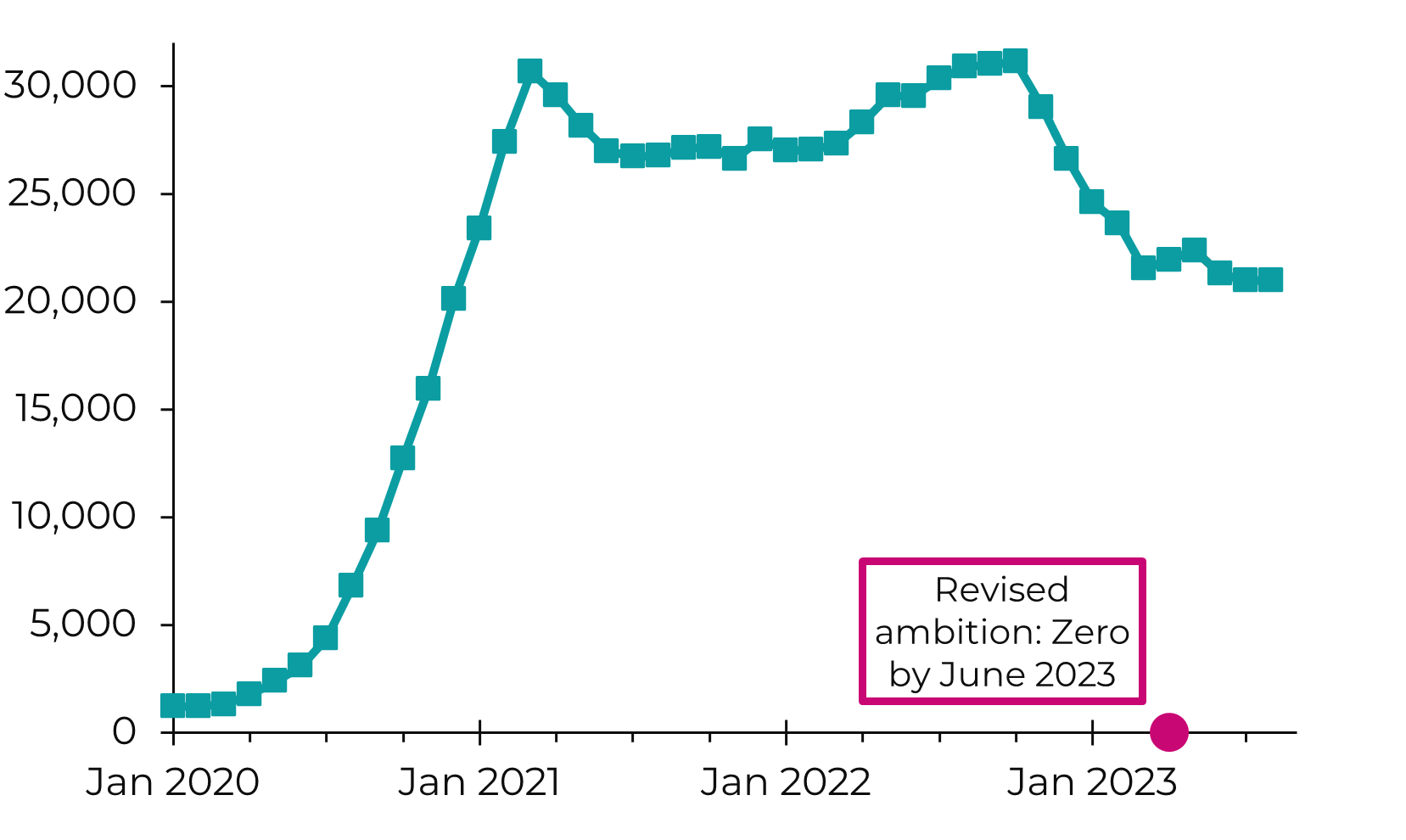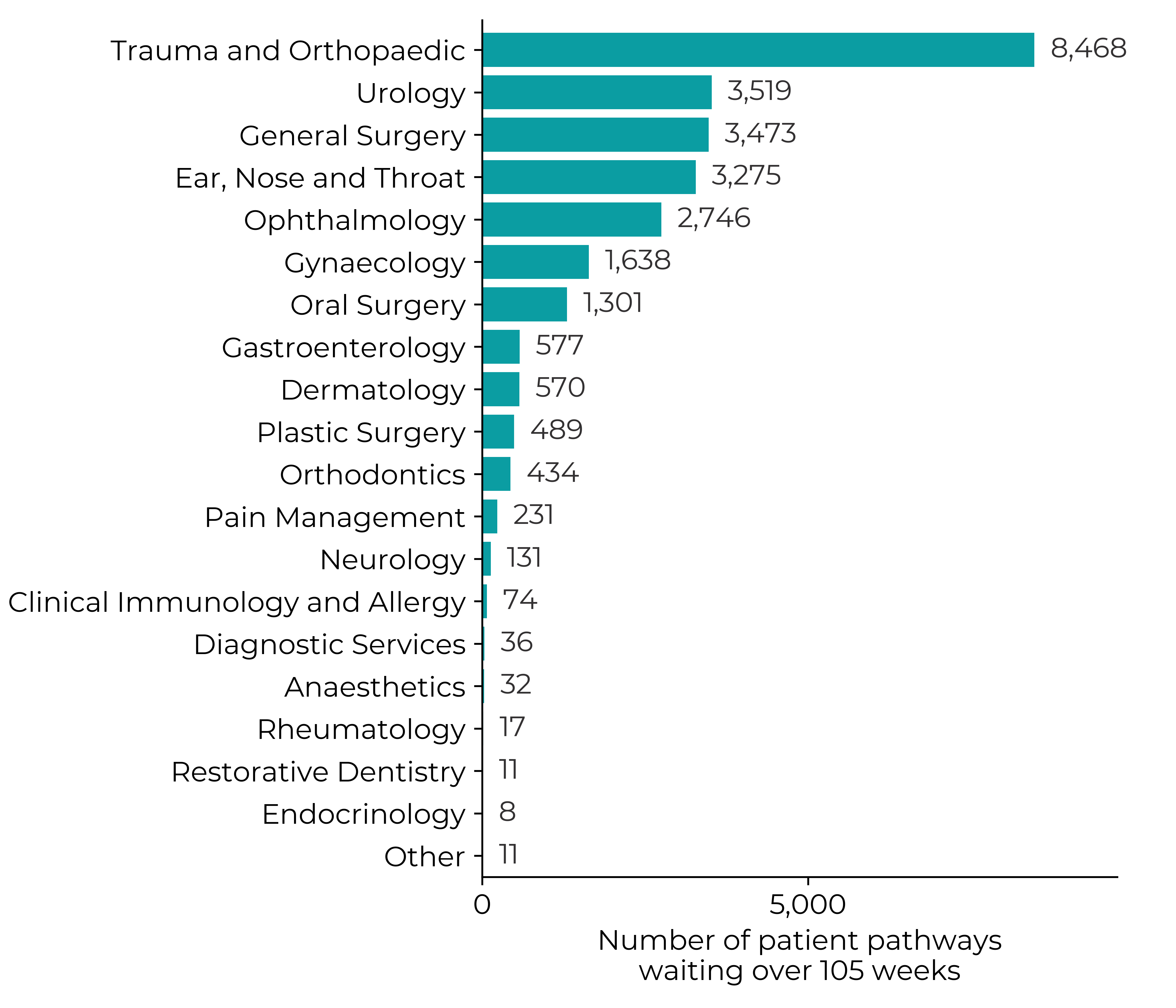With the number of people on NHS waiting lists at a record high, patients in need of certain treatments are facing exceptionally long delays.
In August 2023, the number of patient pathways waiting to start treatment in NHS Wales increased from around 748,400 in May 2023 to around 760,300. This is the sixth consecutive increase and the highest figure on record.
The Welsh Government set health boards a recovery target to eliminate two year waits in most specialties by March 2023, one of five targets set out in its ‘Planned Care Recovery Plan’. The Welsh Government has so far missed all its recovery targets, including the target to eliminate two year waits.
This article focuses on prolonged waits for NHS treatment, specifically current performance against the two year waiting time target.
Prioritising two year waits
The Health Minister, Eluned Morgan MS recently told the Senedd’s Health and Social Care Committee she wants to prioritise patients who have endured the longest wait times for treatment, even if it potentially hinders the Welsh Government’s ability to meet its other planned care recovery targets.
The Deputy Chief Medical Officer for Wales wrote to health boards in April 2023 stating that patients waiting over two years for treatment should be placed in the same category as urgent patients when booking appointments.
The Senedd’s Health and Social Care Committee’s report ‘Waiting Well?’ (April 2022) considered the consequences for patients of extended waiting times for NHS treatment. It found that patient experience in these situations is both physically and emotionally challenging (see our article from June).
The Health and Social Committee found that waiting for treatment can mean enduring ongoing pain or discomfort, with some patients experiencing this for an extended period. Some patients may see their condition worsen during the wait. Patient’s conditions can deteriorate, becoming more complex and challenging, and more time-consuming and costly to treat.
The Committee also found that patients who have endured the longest waiting times are often in a more vulnerable state of mental health, with long waiting times frequently leading to anxiety and stress.
However, there are limitations to an approach that concentrates on addressing the longest waiting times. The King’s Fund has previously noted the complex task of trying to strike the right balance between addressing historical waiting lists and attending to new and pressing cases.
One significant drawback is that it may exacerbate existing disparities in access to healthcare. While providing overdue care is essential, concentrating on this group may inadvertently neglect patients who have urgent needs but have not been waiting as long. For example, the Health Minister is equally committed to ensuring there is a reduction in the backlog of patients waiting too long on the cancer pathway (for whom early diagnosis and treatment is often critical for successful outcomes).
Focusing solely on the longest waiting patients can create a bottleneck in the system. It addresses the symptoms rather than underlying problems within the healthcare system (i.e. the root causes of long waiting lists such as insufficient funding, shortages of healthcare professionals, outdated infrastructure or inefficient processes). This approach doesn’t prioritise preventative measures either, which is recognised as being essential to reduce waiting lists sustainably.
Current performance to reduce two year waits
Despite the significant focus placed on reducing waiting times, performance has worsened in recent months. The number of patient pathways waiting to start treatment in August 2023 was 64.1% higher than at the start of the Covid-19 pandemic in February 2020.
The total number of patient pathways waiting over two years is now falling each month but the numbers remain high in historical context. In August 2023, around 27,000 patient pathways were waiting more than two years to start treatment in most specialities.
A projection by Senedd Research, using data from March to August 2023 shows that at the current rate of progress (i.e. if the rate of progress since March 2023 is sustained), the recovery target to eliminate two year waits in most specialties will be fulfilled around September 2025. The revised target is for health boards to achieve this by March 2024.
Figure 1: Number of patient pathways waiting over 105 weeks to start treatment and projection based on March to August 2023

Source: StatsWales, Patient pathways waiting to start treatment by month, grouped weeks and stage of pathway
In the recovery targets, ‘most’ refers to all specialties excluding seven recognised as exceptionally challenging. One of these seven specialties is trauma and orthopaedic, which includes patients waiting for treatment such as knee and hip replacements. These patients are considerably more likely to have to wait a long time for treatment.
Other challenging specialties with significant waits over two years include: urology, general surgery, Ear, Nose and Throat, ophthalmology, gynaecology and oral surgery.
Figure 2: Number of patient pathways waiting over 105 weeks to start treatment for the pathways with the longest waits (i.e. by treatment function)

Source: StatsWales, Patient pathways waiting to start treatment by month, grouped weeks and treatment function, January 2021 onwards
Two year waits in England
The Welsh Government says NHS Wales waiting time performance should not be compared to NHS England due to variations in how waiting time data is collected and reported. This can make direct comparisons misleading. For that reason, we haven’t compared waiting times here. NHS England says it has ‘virtually eliminated two-year waits’.
Next steps in reducing the backlog
Prioritising patients with the longest wait times for NHS treatment is a stated priority for the Welsh Government. The Health and Social Care Committee said in its report, it’s crucial for the thousands of people waiting in pain or anxiety. However, the report also recognised this must be done at the same time as addressing the systematic issues responsible for these extended wait times, ultimately facilitating the reduction of the backlog.
You can check the progress the Welsh Government is making against its five recovery targets for planned care by reading our termly NHS Waiting List Monitoring Reports, published by the Senedd’s Health and Social Care Committee.
Article by Sarah Hatherley, Helen Jones and Joe Wilkes, Senedd Research, Welsh Parliament






